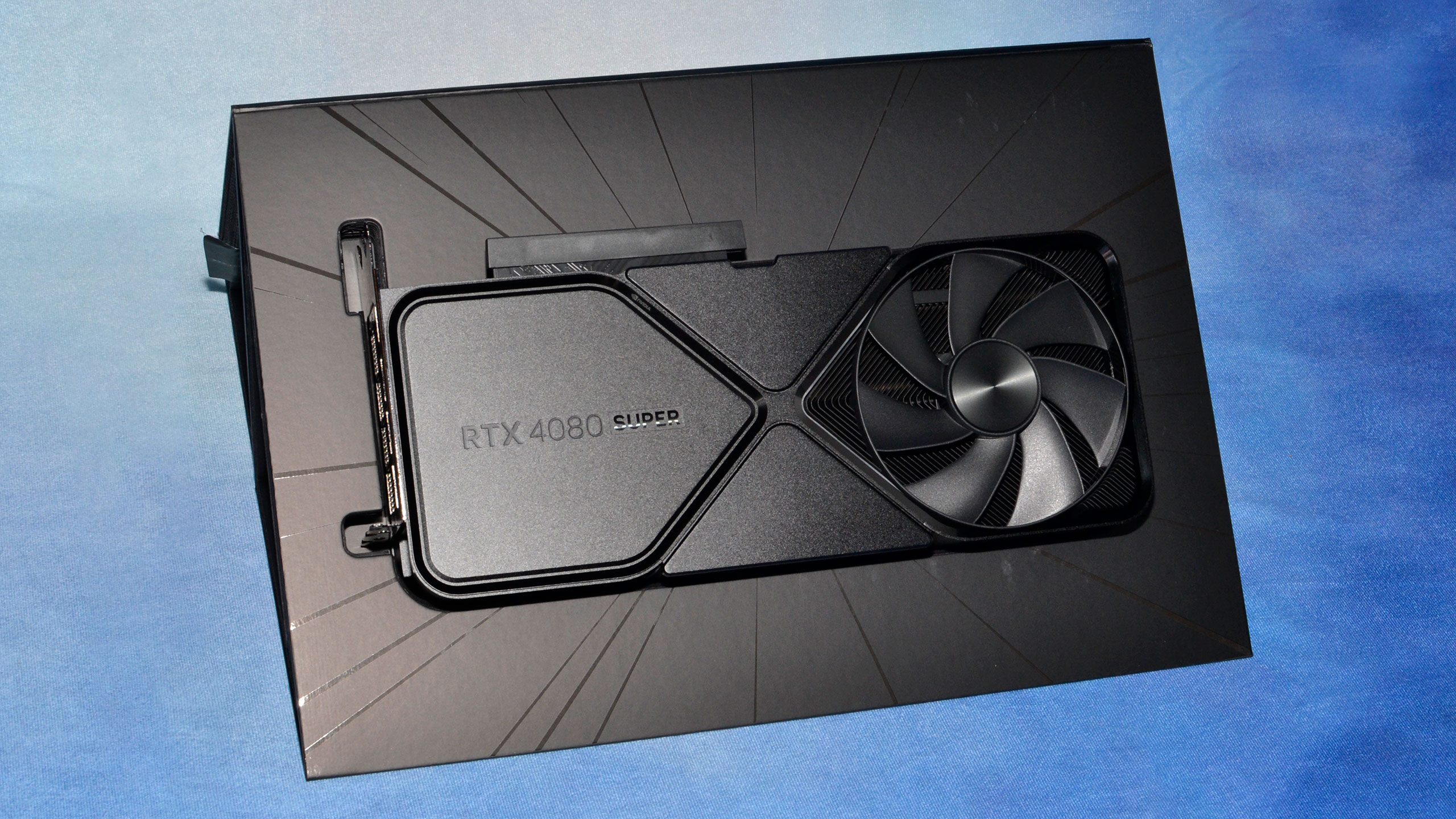Why you can trust Tom's Hardware
Nvidia RTX 4080 Super AI Performance
GPUs, particularly high-end solutions like the RTX 4080 Super, can also used with professional applications, AI training and inferencing, and more. Along with our usual professional tests, we have Stable Diffusion benchmarks on the various GPUs. AI is a fast-moving sector, with many of the publicly available projects designed specifically to run on Nvidia GPUs. That may be changing, slowly, but Nvidia remains the leader in AI right now.
For our AI testing, we're using Automatic1111's Stable Diffusion project for the Nvidia cards, with the TensorRT extensions enabled. Intel has an OpenVINO fork of Automatic1111's repository, which shows about a 50% improvement over our previous testing. Finally, AMD has a DirectML fork of Automatic1111 that's tuned for the RDNA 3 GPUs we're testing.
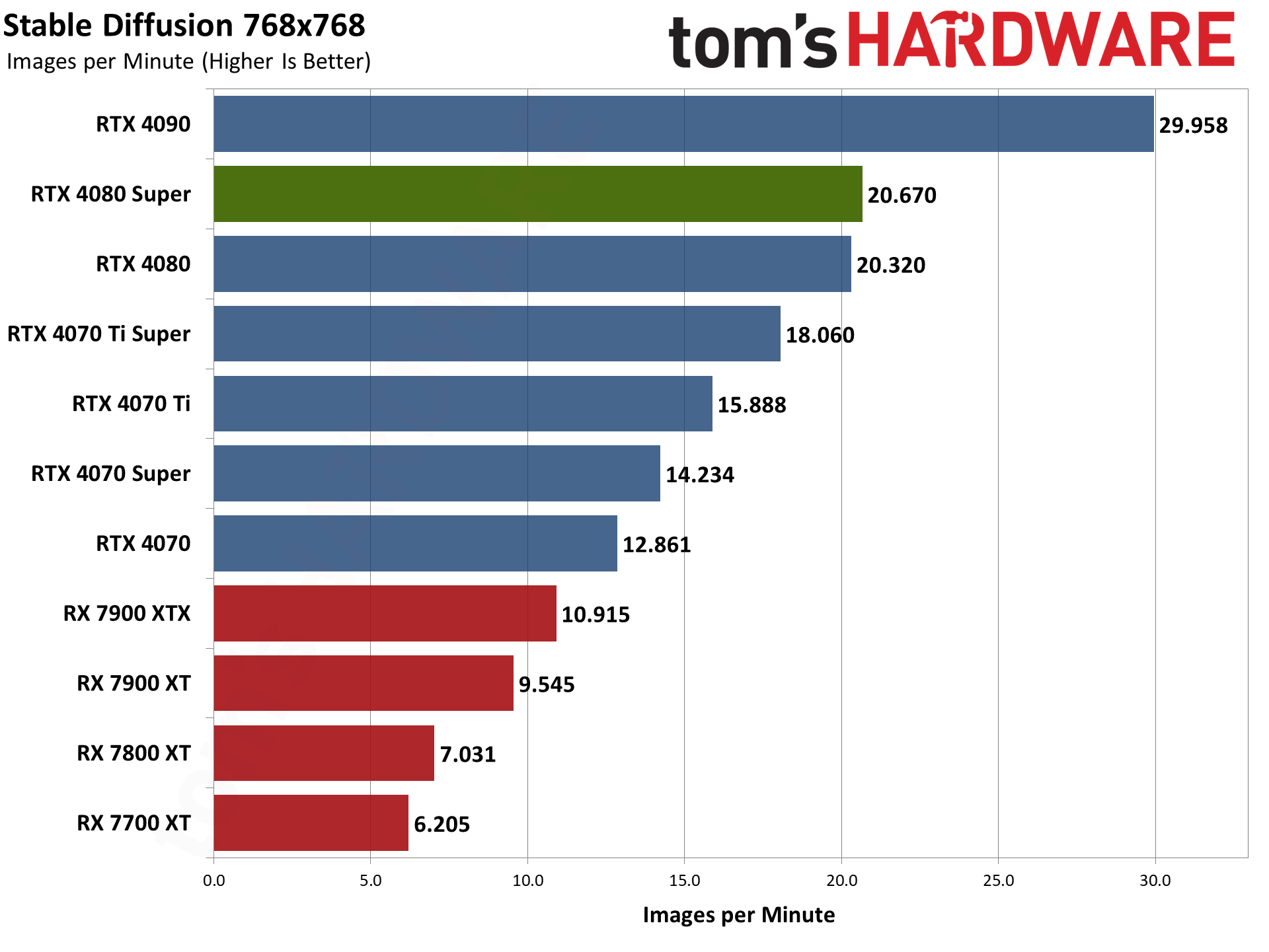

Compared to what we already had in the form of vanilla RTX 4080, the RTX 4080 Super once again doesn't really change the status quo as far as performance goes. It's 2% faster in Stable Diffussion at 768x768, and we measured a 6% gain at 512x512 but that's likely an extra 2% margin of error (because there's no reason for the 4080 Super to be more than 5% ahead of the 4080).
The RTX 4090 of course reigns supreme, with 45% higher performance at 768x768. It also has 50% more memory, which means it's able to run larger models that simply don't fit into the 16GB on the 4080 Super and 4080. If you're serious about AI work, and a lot of companies are, it's easy enough to see why the 4090 prices have increased in the past year.
The RTX 4080 Super also easily outpaces anything from AMD in this discipline. It's 90% faster at 768x768 and 108% faster at 512x512 image generation. There may be workloads where AMD is more competitive, and like the 4090, the 7900 XTX also has 24GB of VRAM that can be useful for running larger models. But AI also needs a lot of compute, and that's an area where Nvidia's tensor cores push it far into the lead.
Nvidia RTX 4080 Super Professional Workloads
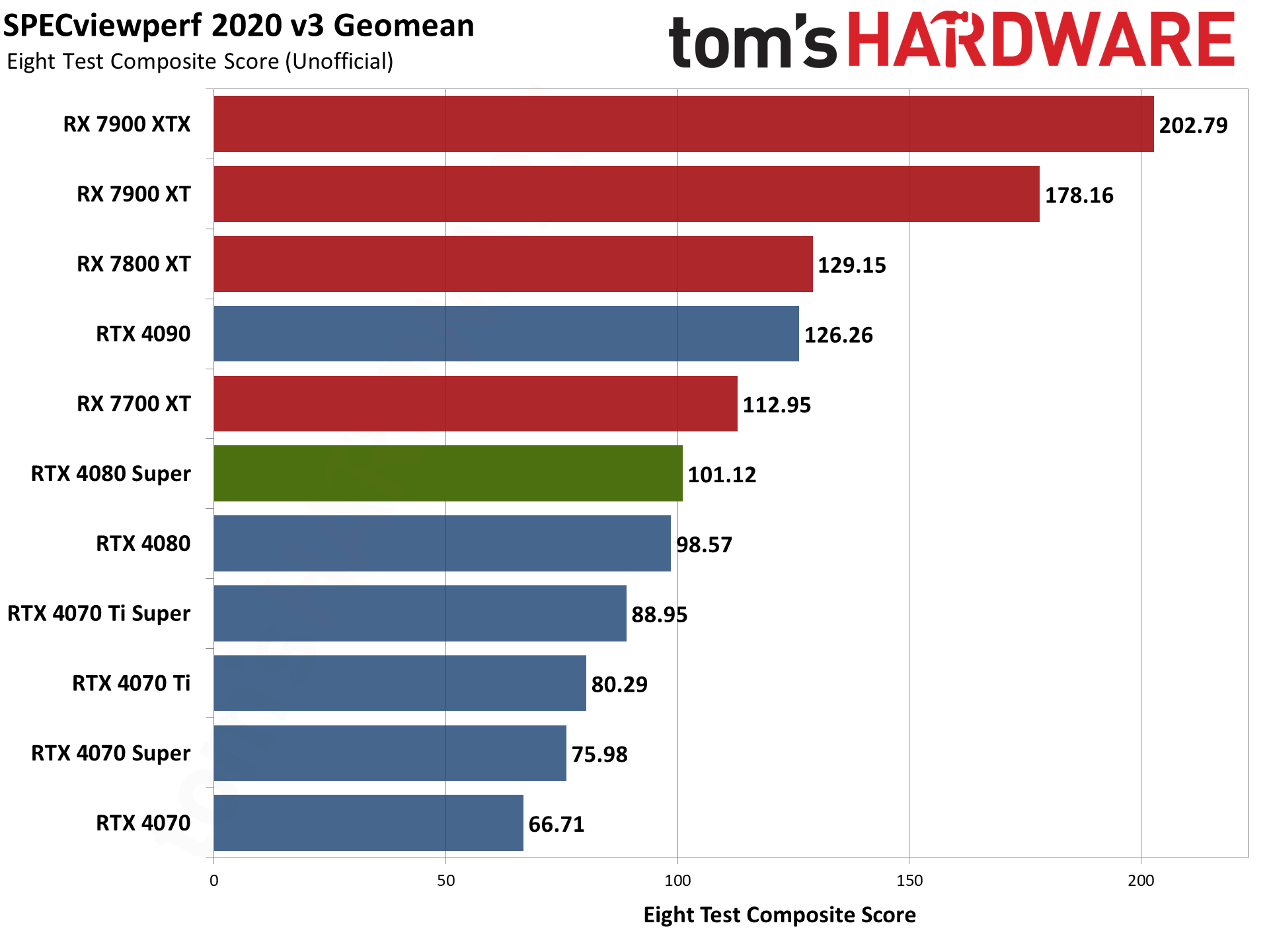
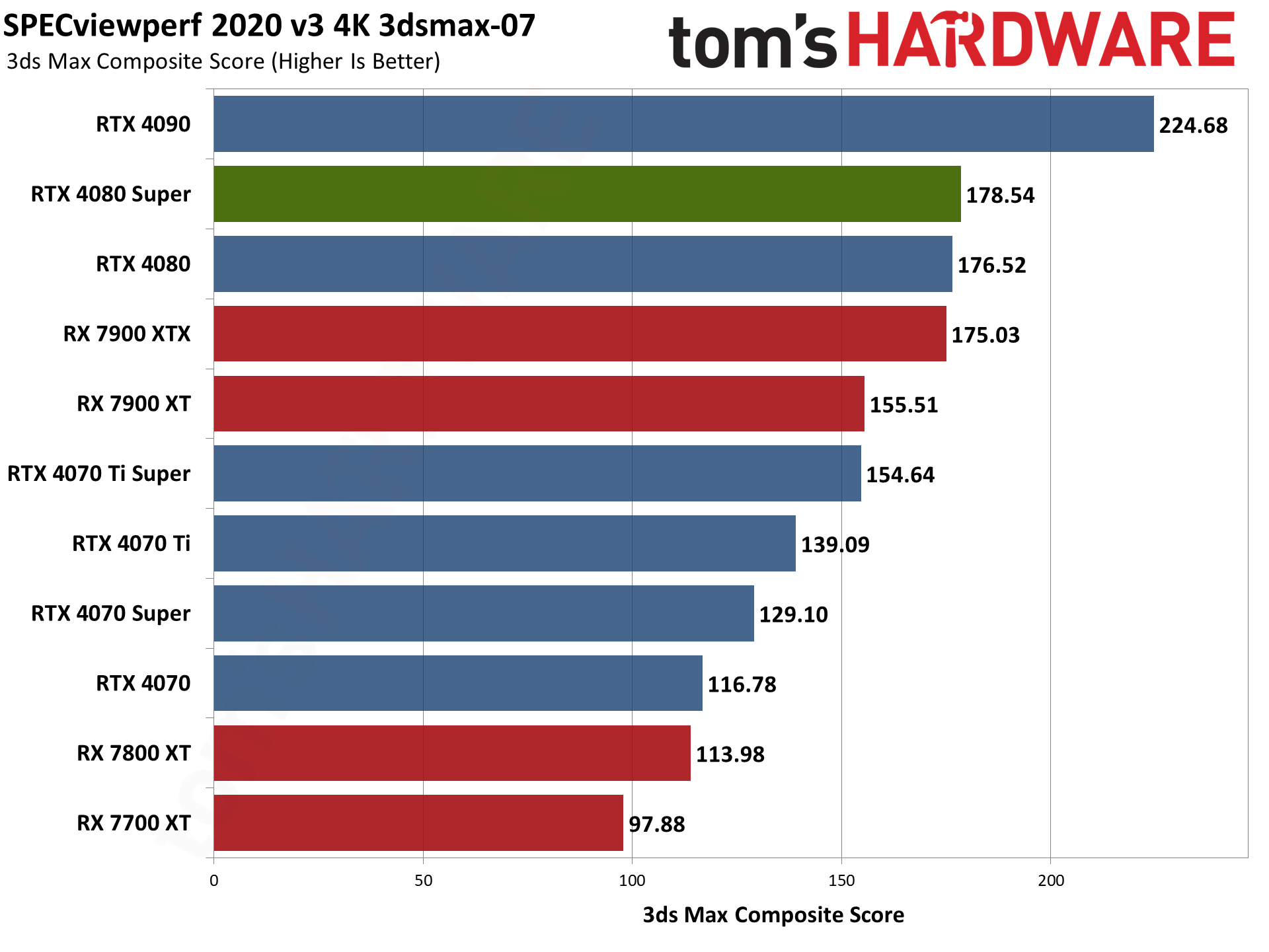
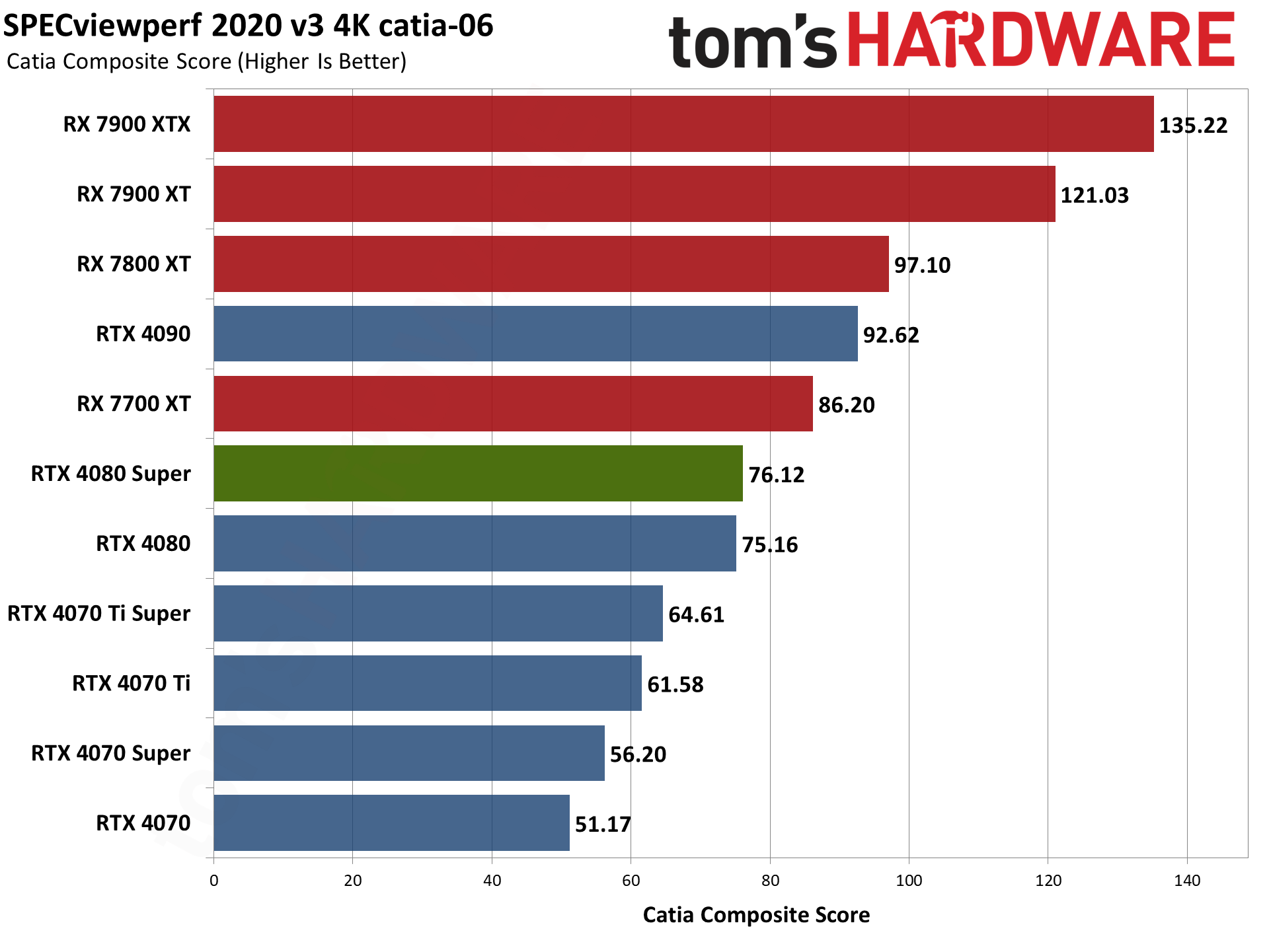
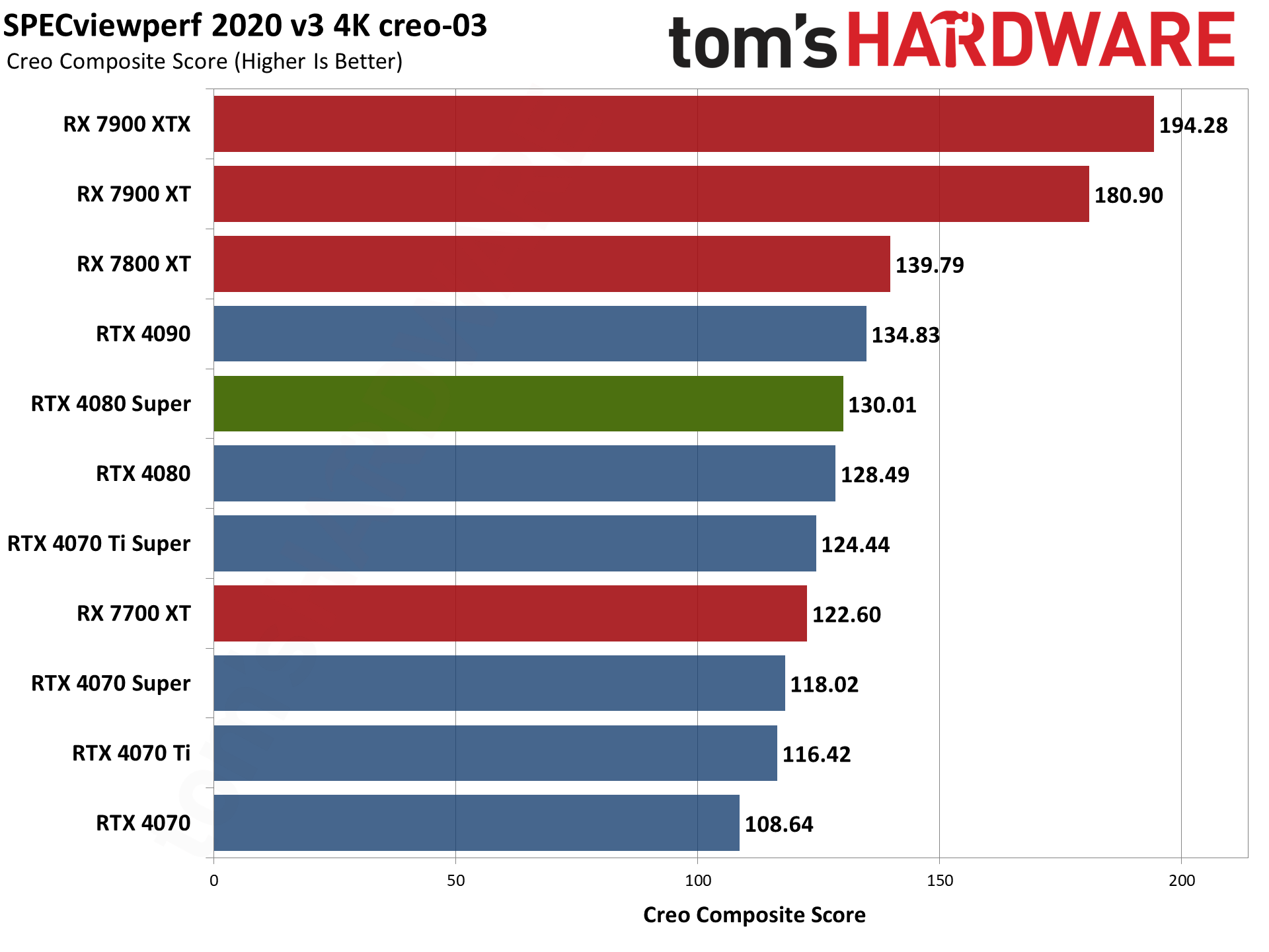
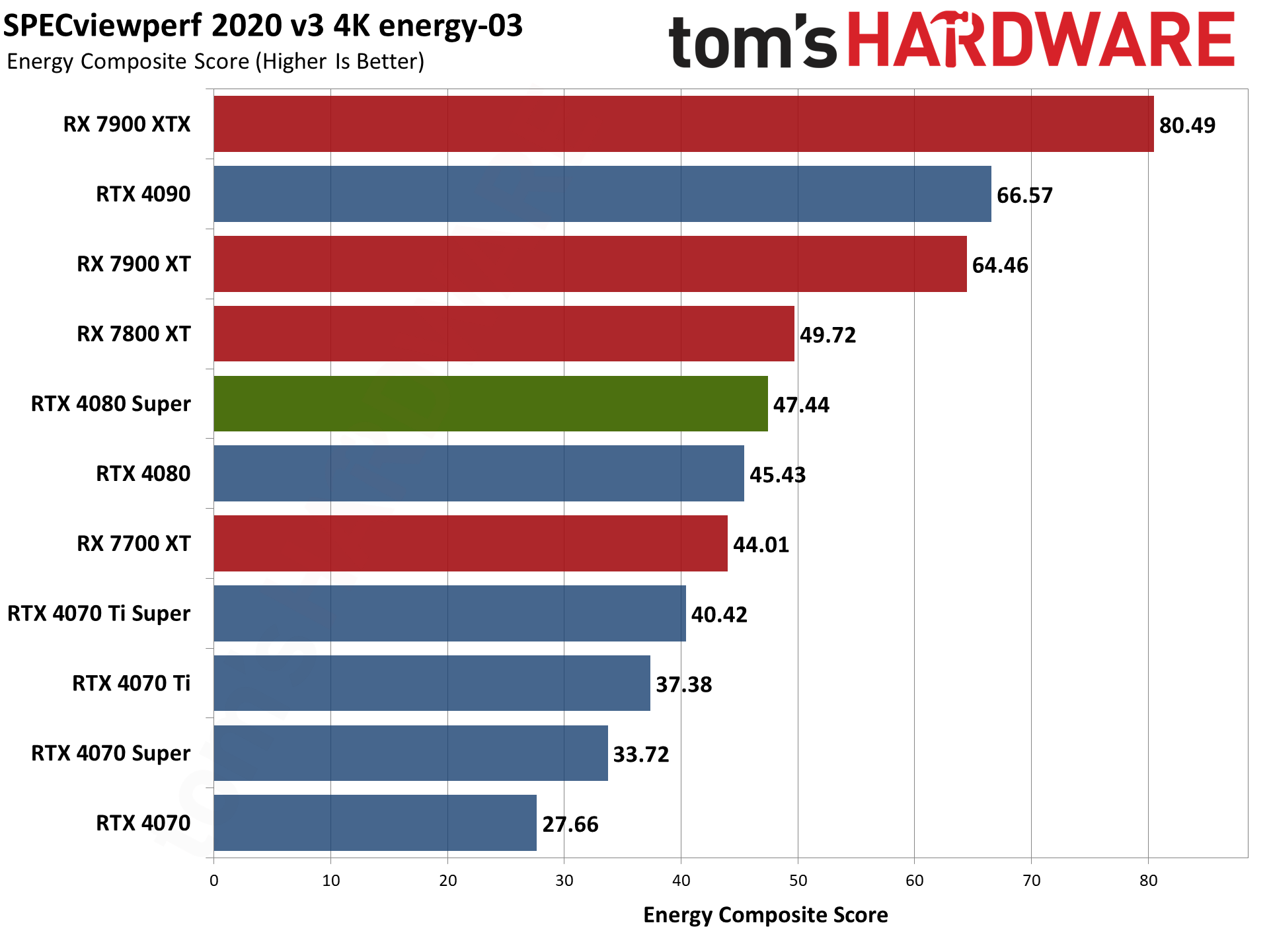
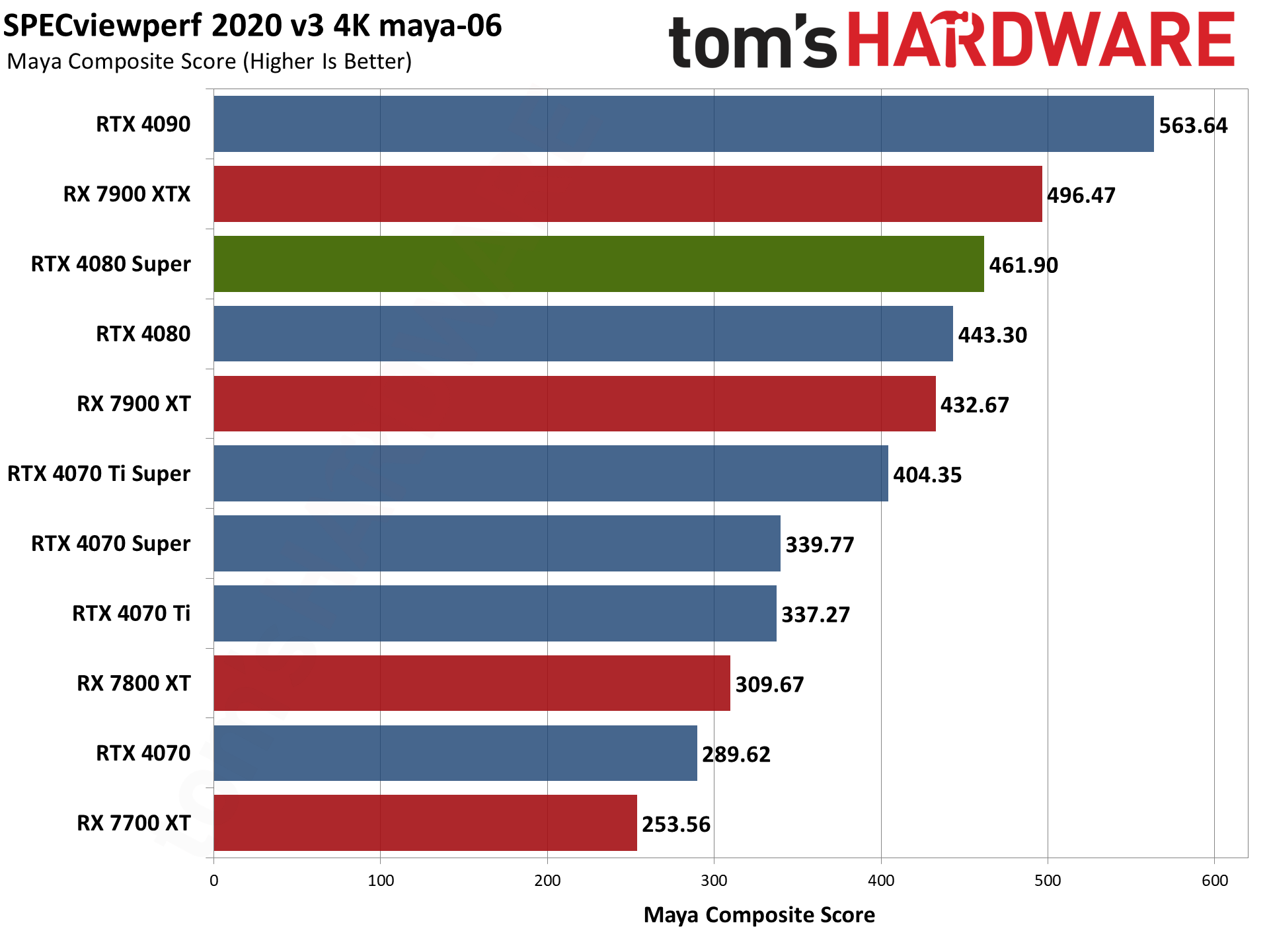
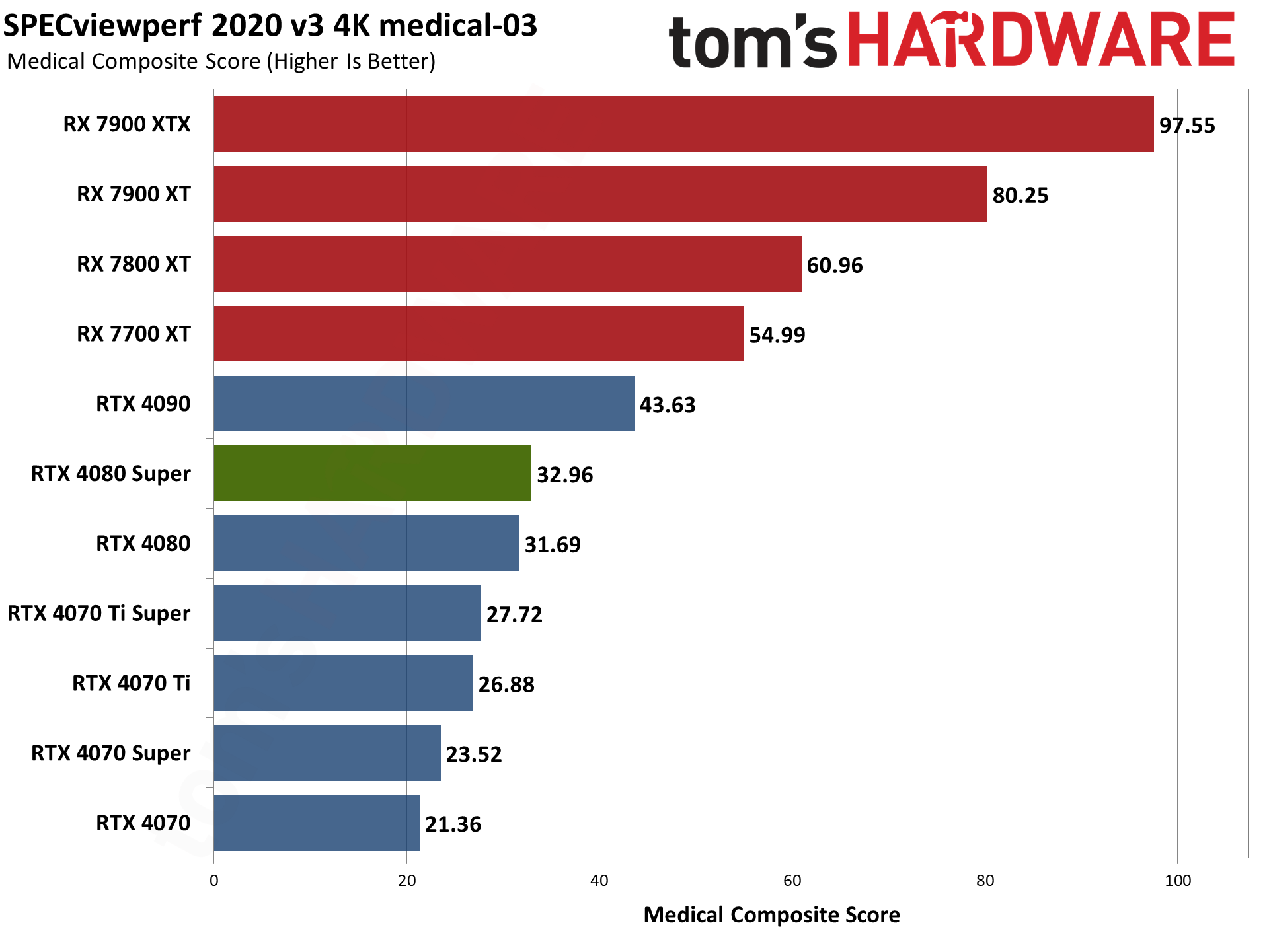
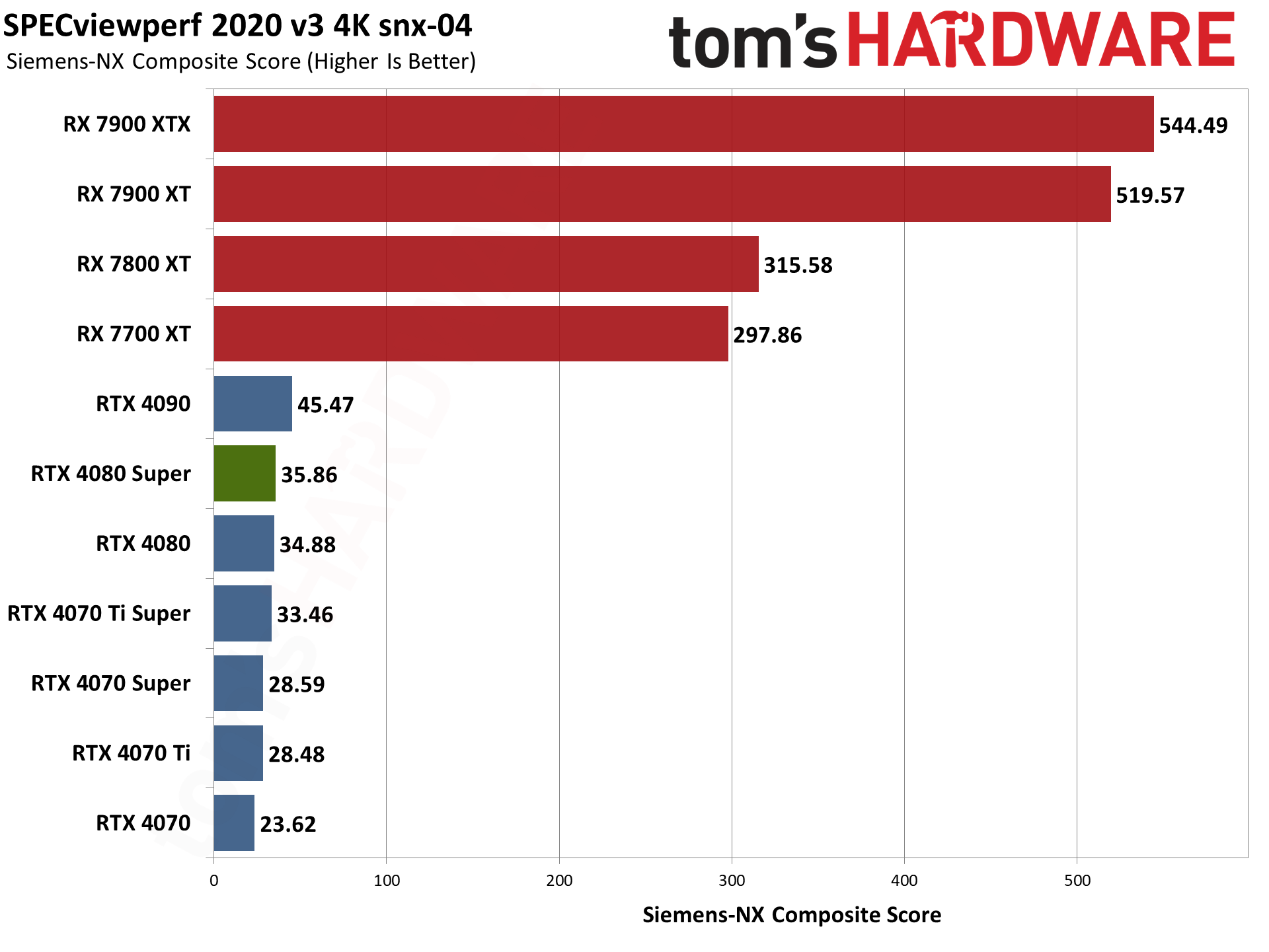
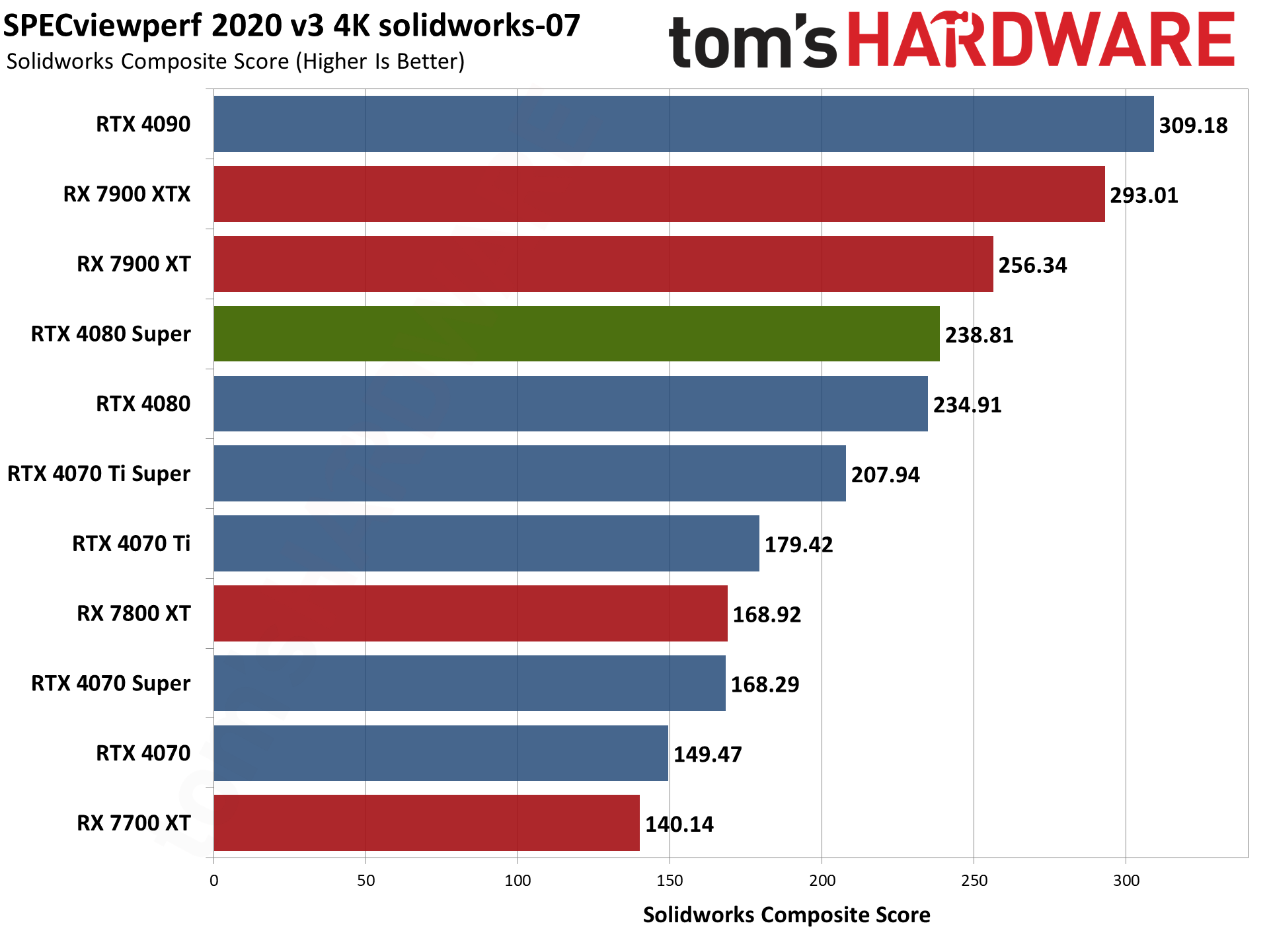
We use SPECviewperf 2020 v3 as one of our benchmarks for assessing professional workstation graphics performance. This is an area where Nvidia's consumer GPUs fall far behind at times, as it only offers full performance tuning in its drivers for professional GPUs like the RTX 5000 Ada Generation.
Depending on the application, the competition from AMD can be substantially faster, only moderately faster, or slightly behind — actually, the 3dsmax-07 test is the only one where the 4080 Super beat the 7900 XTX, and only by 2%. In the remaining seven tests, the 7900 XTX leads the 4080 Super by anywhere from 8% (maya-06) to nearly 200% (medical-03), with snx-04 being the outlier where AMD's GPU is over 1400% faster.
Naturally, the 4080 Super shows no real advantage over the 4080 once again. It's 2.6% faster overall, leading by 1.1–4.4 percent in the eight individual tests. And the 4090 delivers 25% higher performance overall, with a range from 3.7–40.3 percent. Most of the results are 20% or more, but creo-03 doesn't appear to scale much with the faster GPUs.
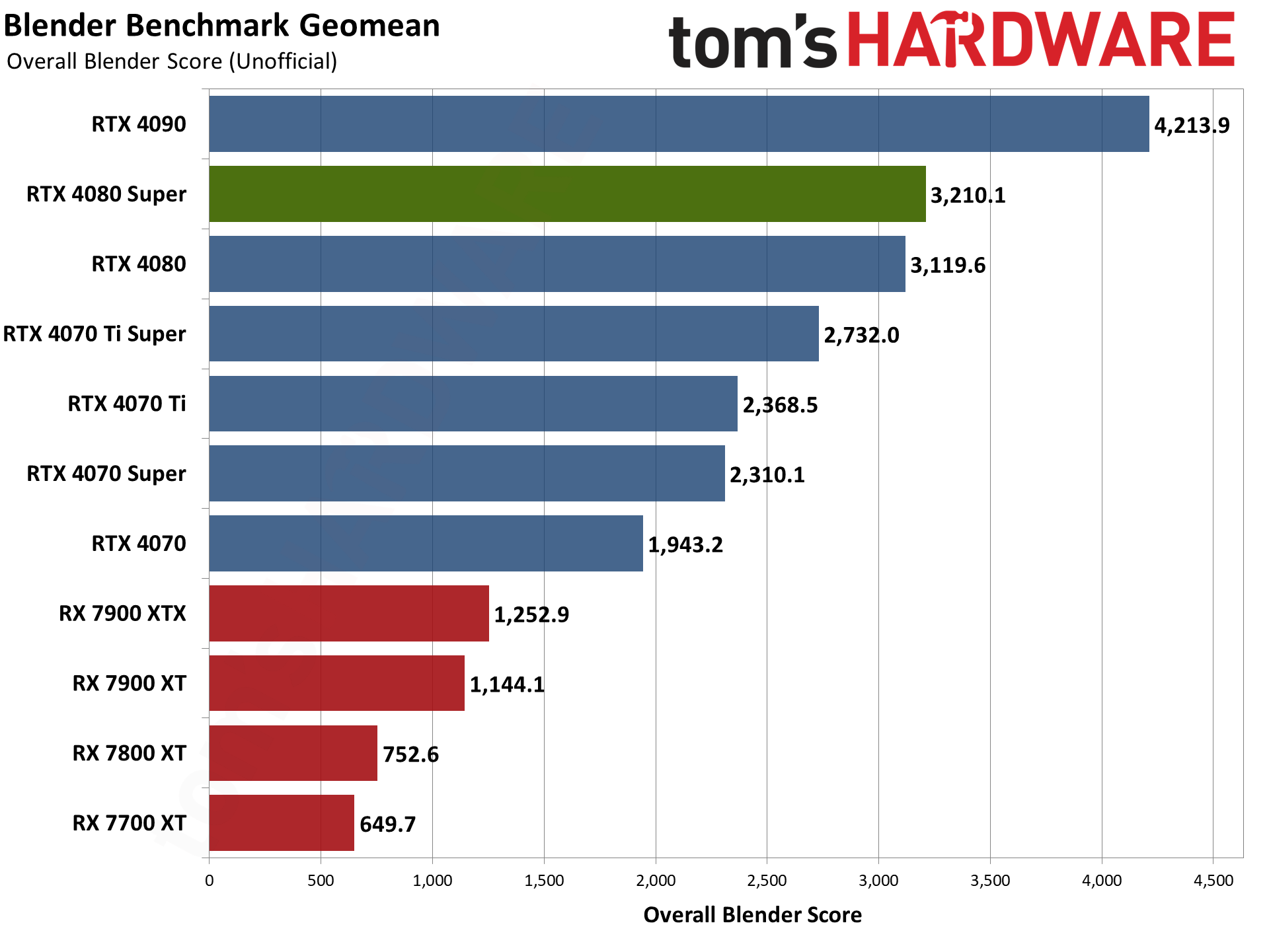
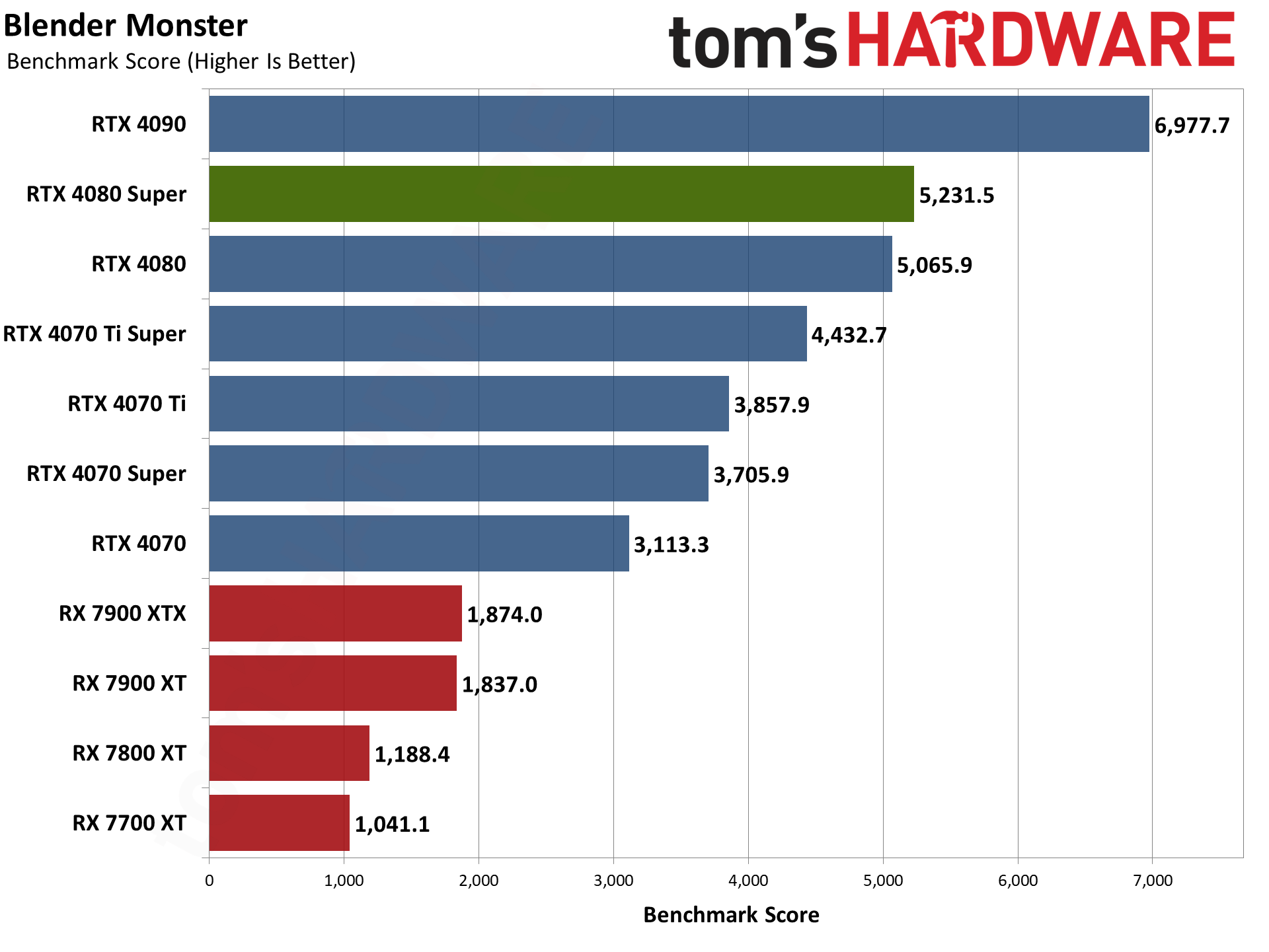
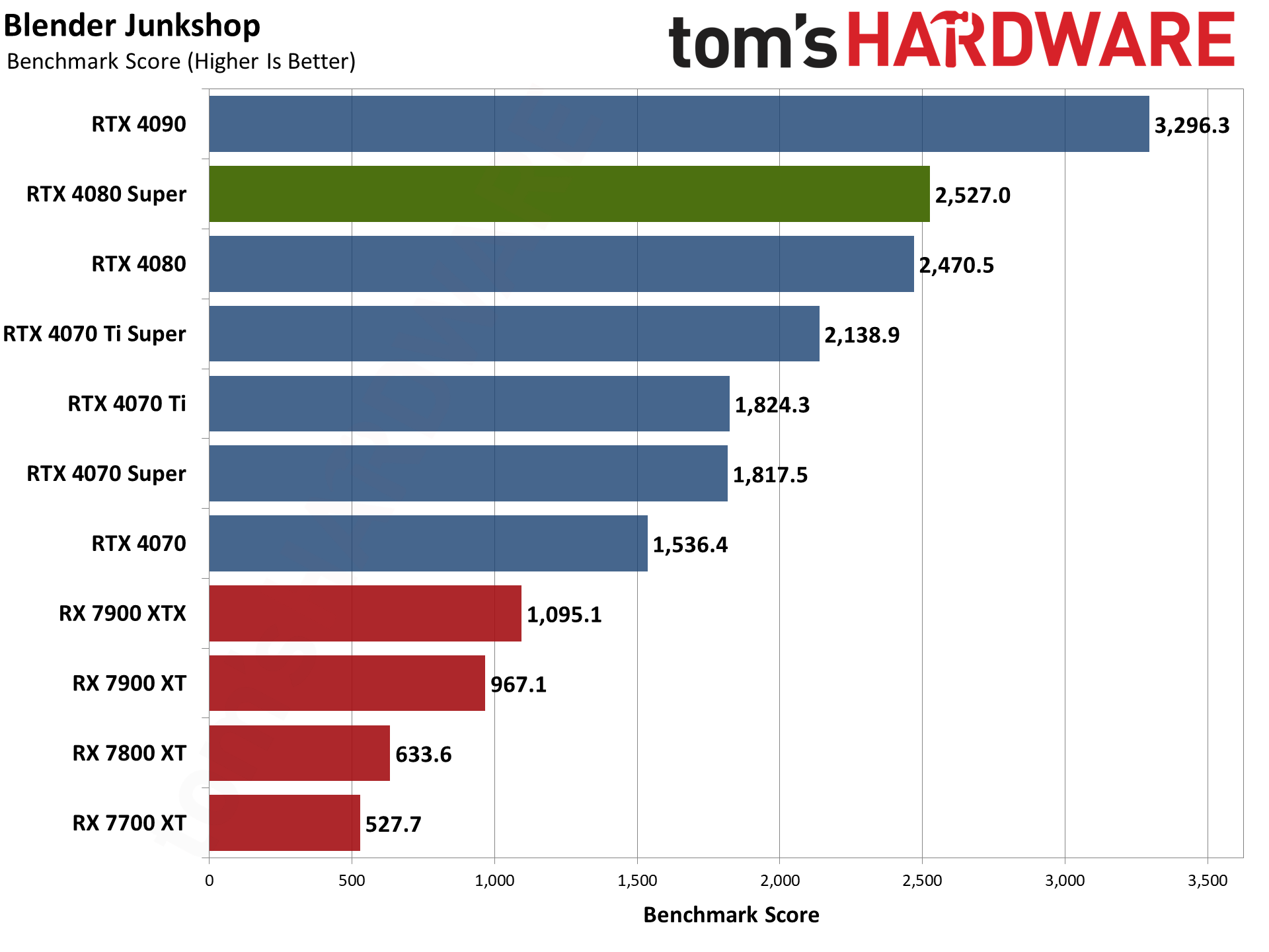

For GPU-accelerated 3D rendering, the only app that currently supports all three GPU vendors is Blender. It leverages the ray tracing hardware to boost performance, and that generally puts Nvidia in the pole position. We're using Blender Benchmark, version 3.6.0, though Blender version 4.0.0 is also available. We've found some GPUs, including all of the Nvidia models, perform better with version 3.6.0, and it's not clear whether 4.0.0 executes the same workload or if it does extra calculations to deliver a better result.
Like our ray tracing game results, the 4080 Super delivers a beatdown to AMD's top RX 7900 XTX. It's 156% faster overall, and 131–179 percent faster in the three individual tests. Nvidia also has hardware acceleration for other professional 3D rendering applications (see below).
The 4080 Super offers 3% higher performance than the vanilla 4080, so again nothing no write home about. The RTX 4090 meanwhile delivers around 30% more performance than the 4080 Super. For 3D rendering, time can directly equate to money, and the higher cost of the 4090 — or a professional GPU like the RTX 6000 Ada — can be justifiable.
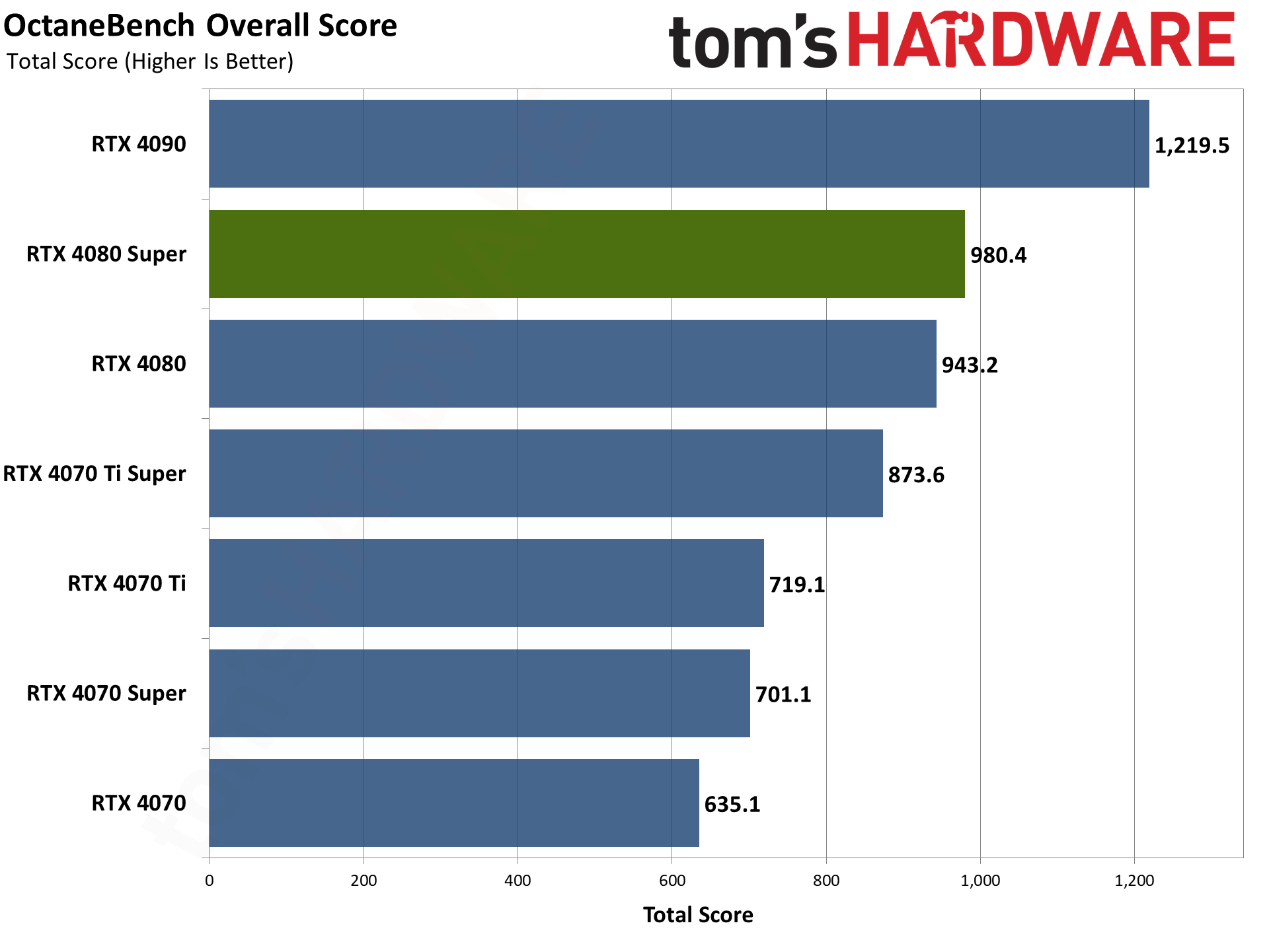
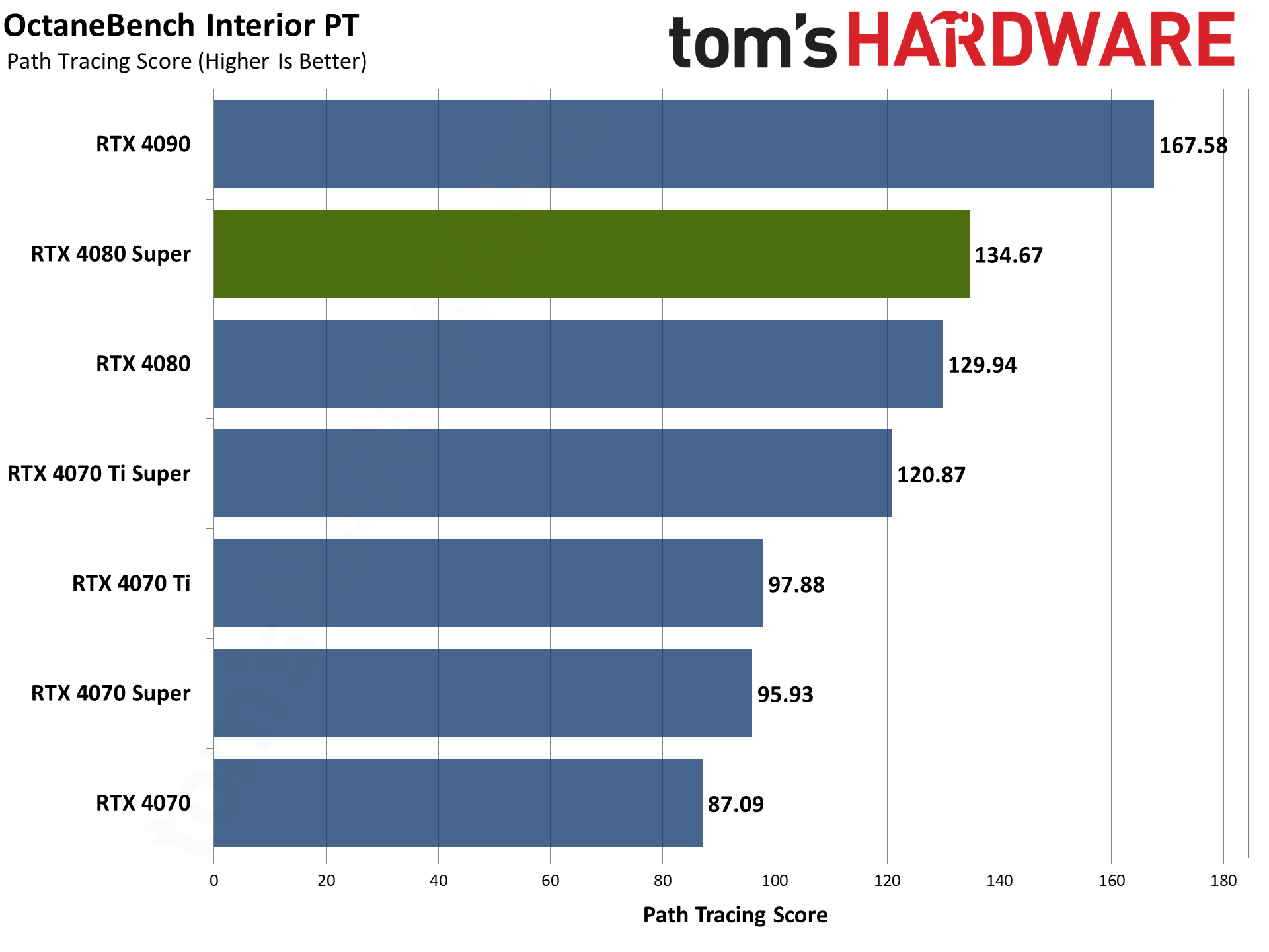
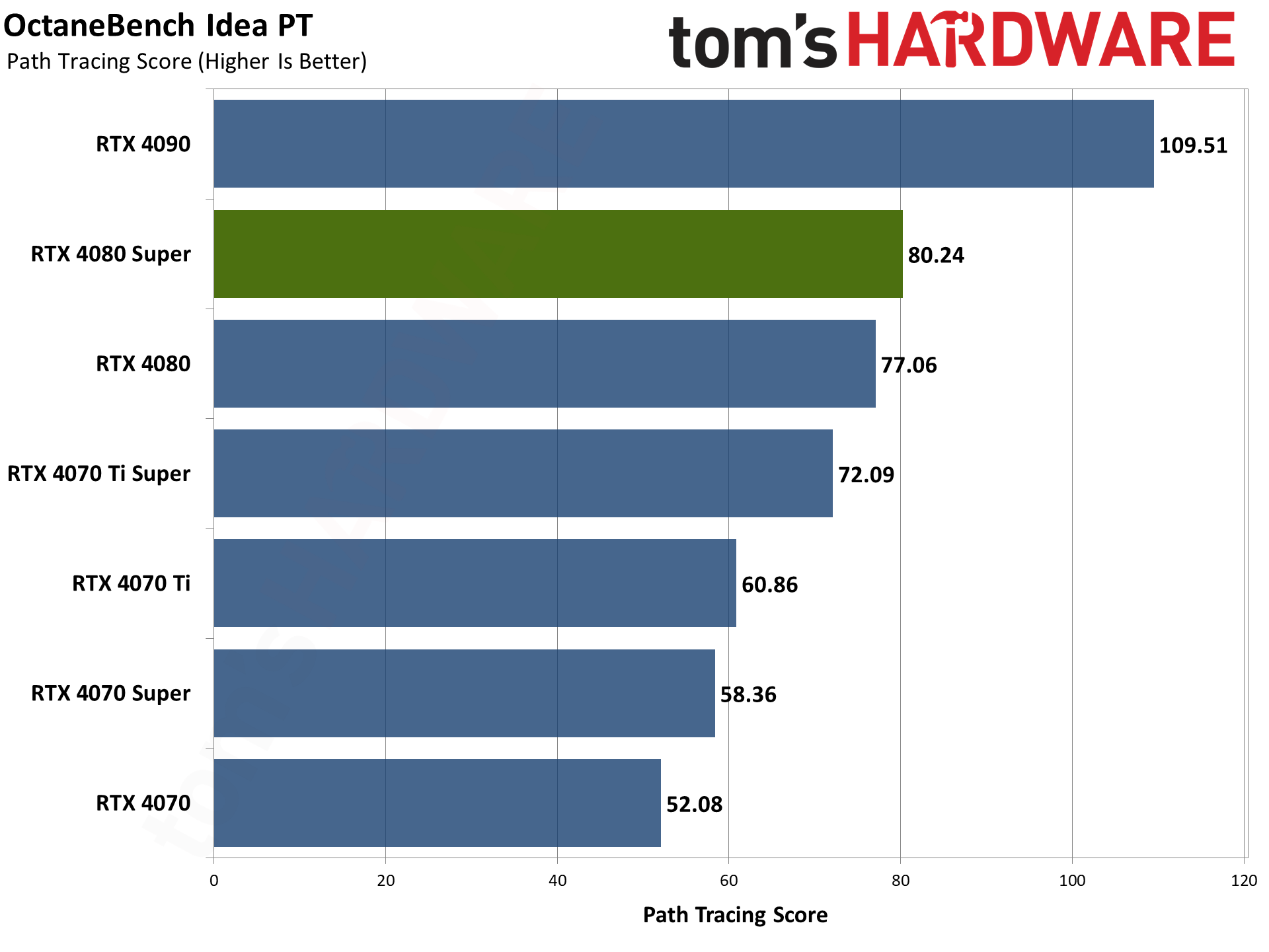
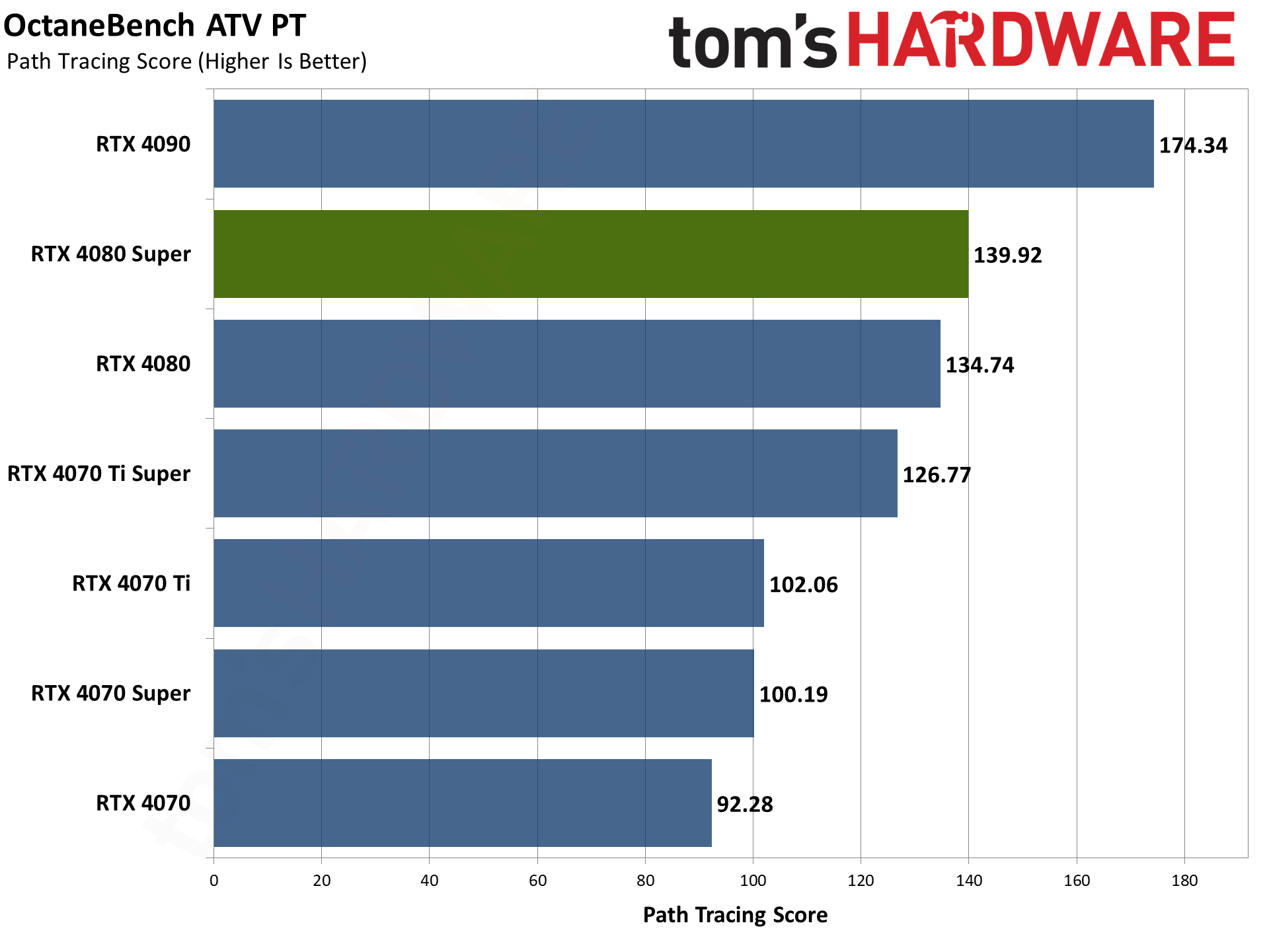
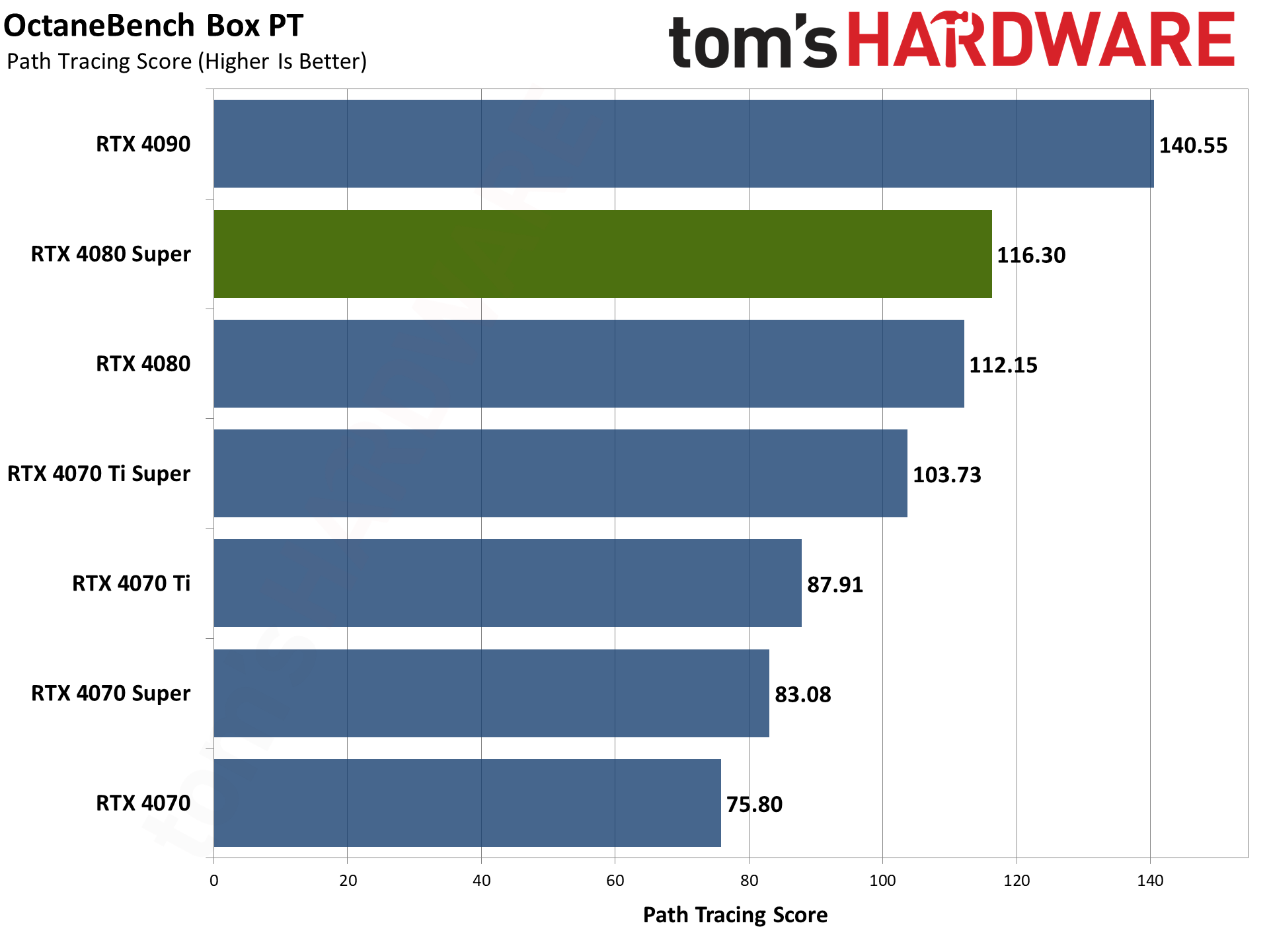
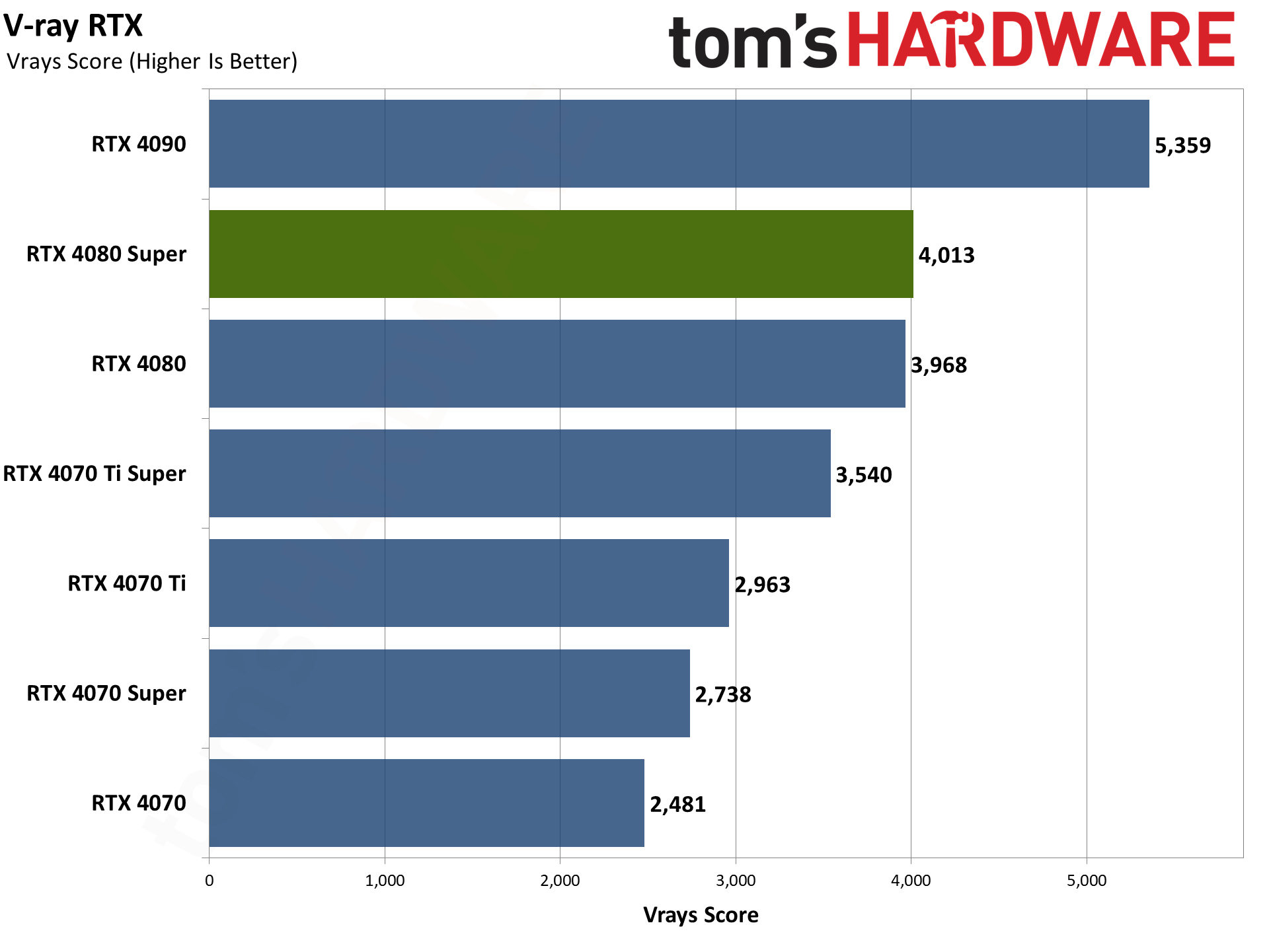
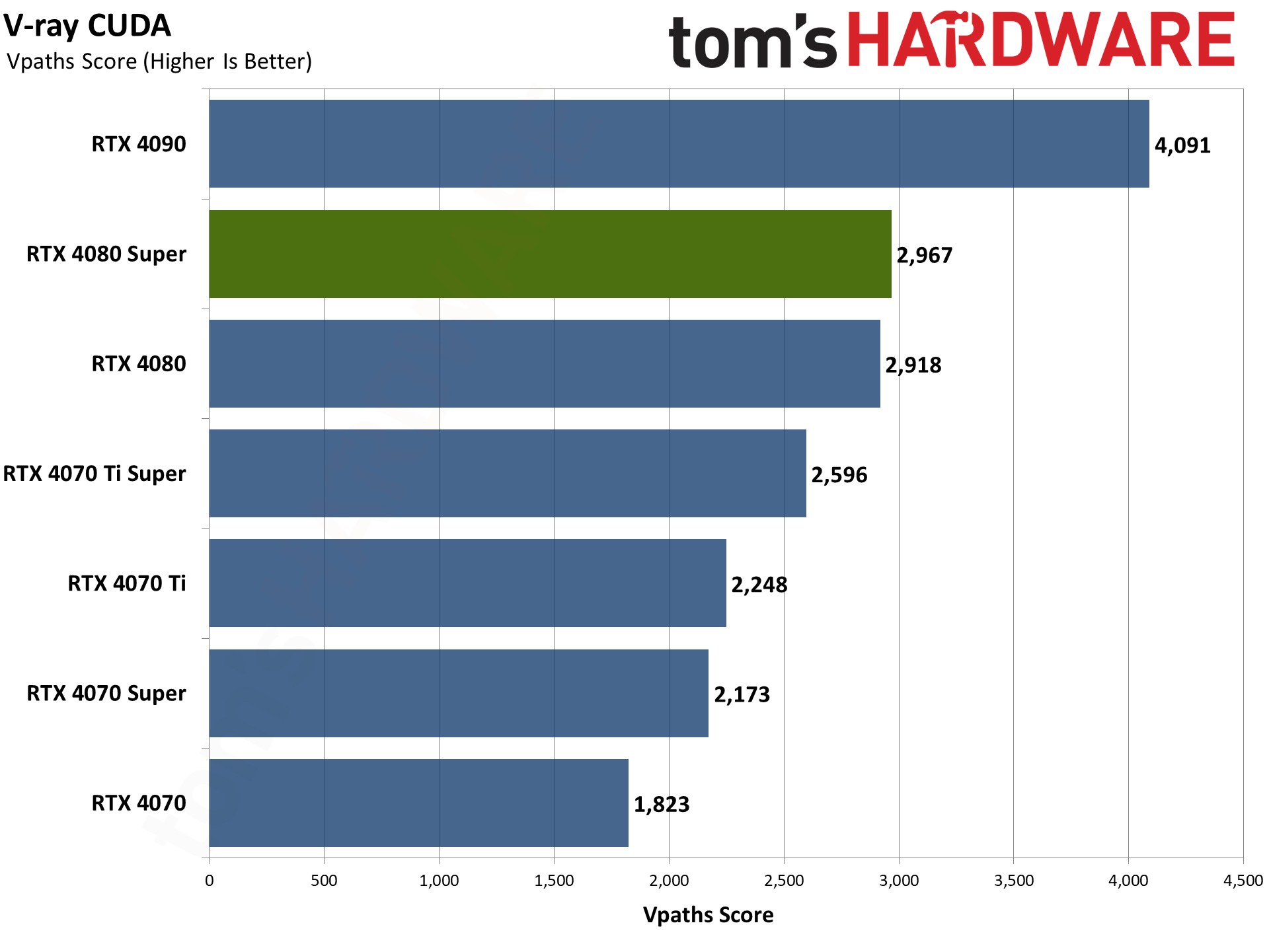
Nvidia has RT hardware acceleration for Otoy OctaneRender and V-Ray, which do not have support for AMD or Intel GPUs. The 4080 Super occupies its normal spot, 1–4 percent ahead of the 4080 and 17–28 percent behind the beefier RTX 4090.
Nvidia RTX 4080 Super Content Creation Summary
As one of the fastest consumer GPUs around, it's more feasible for the RTX 4080 Super to be used as a semi-professional substitute that doesn't cost an arm and a leg. If you're mostly doing AI or 3D rendering, it's plenty fast, but Nvidia's pro GPUs can offer double the VRAM (or more) for larger workloads.
If you want a competent GPU for poking at AI, the 4080 Super also works well. It doesn't have as much memory as the 4090, but if you're not specifically looking to run the largest LLMs a consumer GPU can handle, it's a good solution for research and development purposes.
- MORE: Best Graphics Cards
- MORE: GPU Benchmarks and Hierarchy
- MORE: All Graphics Content
Get Tom's Hardware's best news and in-depth reviews, straight to your inbox.
Current page: Nvidia RTX 4080 Super: Professional Content Creation and AI Performance
Prev Page Nvidia RTX 4080 Super: 1080p Gaming Performance Next Page Nvidia RTX 4080 Super: Power, Clocks, Temps, and Noise
Jarred Walton is a senior editor at Tom's Hardware focusing on everything GPU. He has been working as a tech journalist since 2004, writing for AnandTech, Maximum PC, and PC Gamer. From the first S3 Virge '3D decelerators' to today's GPUs, Jarred keeps up with all the latest graphics trends and is the one to ask about game performance.
-
Lamarr the Strelok $1000 for 16 GB VRAM. What a ripoff. Personally the 7600 XT with 16 GB VRAM is the only GPU I'd consider.Nvidia has better performance but their greed is incredible.Reply
I'll be using my 8 GB RX 570 til it's wheels fall off. Then I may simply be done with PC gaming. It's becoming ridiculous now. -
usertests Reply
I'm not going to tell you to continue PC gaming but there are plenty of options that are good enough for whatever you're doing, like an RX 6600. If you want more VRAM, grab a 6700 XT instead of 7600 XT, or an RTX 3060, while supplies last. Then if we later see the RX 7600 8GB migrate down to $200, and 7700 XT 12GB down to $350, those will be perfectly fine cards.Lamarr the Strelok said:$1000 for 16 GB VRAM. What a ripoff. Personally the 7600 XT with 16 GB VRAM is the only GPU I'd consider.Nvidia has better performance but their greed is incredible.
I'll be using my 8 GB RX 570 til it's wheels fall off. Then I may simply be done with PC gaming. It's becoming ridiculous now.
By the time you're done hodling your RX 570, the 7600 XT should be under $300 and at least RDNA4 and Blackwell GPUs will be out. -
RandomWan ReplyLamarr the Strelok said:$1000 for 16 GB VRAM. What a ripoff. Personally the 7600 XT with 16 GB VRAM is the only GPU I'd consider.Nvidia has better performance but their greed is incredible.
I'll be using my 8 GB RX 570 til it's wheels fall off. Then I may simply be done with PC gaming. It's becoming ridiculous now.
You're complaining about the VRAM (which doesn't matter as much as you think) and the price when you're sporting a bottom budget card. There's any number of cards you could upgrade to with a $300 budget that will blow that 570 out of the water.
These should be over 2x the performance of your card with 16GB for $330:
https://pcpartpicker.com/product/vT9wrH/xfx-speedster-swft-210-radeon-rx-7600-xt-16-gb-video-card-rx-76tswftfp
https://pcpartpicker.com/product/sqyH99/gigabyte-gaming-oc-radeon-rx-7600-xt-16-gb-video-card-gv-r76xtgaming-oc-16gd -
Gururu I thought healthy competition between companies meant the customer wins. This proves not the case. They do just enough to edge the competition when they could do soooo much more for the customer.Reply -
TerryLaze Reply
Being cheaper is not a bad thing, it's not contradictory to the first thing being good ( the slightly faster) it's not but cheaper, it's but also or and(also) cheaper.Admin said:Nvidia GeForce RTX 4080 Super review: Slightly faster than the 4080, but $200 cheaper : Read more -
InvalidError Reply
If nobody complains about ludicrously expensive GPUs having a bunch of corners cut off everywhere to pinch a few dollars on manufacturing off a $1000 luxury product, that is only an invitation to do even worse next time. No GPU over $250 should have less than 12GB of VRAM, which makes 16GB at $1000 look pathetic.RandomWan said:You're complaining about the VRAM (which doesn't matter as much as you think) and the price when you're sporting a bottom budget card.
Also, having 12+GB does matter as higher resolution textures are usually the most obvious image quality improvement with little to no impact on frame rate as long as you have sufficient VRAM to spare and 8GB is starting to cause lots of visible LoD asset pops in modern titles.
Corporations' highest priority customers are the shareholders and shareholders want infinite 40% YoY growth with the least benefits possible to the retail end-users as giving end-users too much value for their money would mean hitting the end of the road for what can be cost-effectively delivered that much sooner and be able to milk customers for that many fewer product cycles.Gururu said:I thought healthy competition between companies meant the customer wins. This proves not the case. They do just enough to edge the competition when they could do soooo much more for the customer. -
TerryLaze Reply
The last time we had healthy competition in anything computer related was in the 90ies.Gururu said:I thought healthy competition between companies meant the customer wins. This proves not the case. They do just enough to edge the competition when they could do soooo much more for the customer.
AMD buying ATI in 2006 was the last of any "healthy" competition, every other GPU company at that point was already defeated, also every other CPU company other that intel and AMD with ARM, as a company, barely hanging on even though ARM as CPUs are almost everywhere. -
magbarn As long as Nvidia makes a killing on AI, they're going to reserve the fat chips like the 4090 only for the highest priced products. They're allocating most of the large chips to AI, hence why the 4090 at MSRP sold out in minutes yesterday. This 4080 Super really is what the 4070 Ti should've been.Reply -
RandomWan ReplyInvalidError said:If nobody complains about ludicrously expensive GPUs having a bunch of corners cut off everywhere to pinch a few dollars on manufacturing off a $1000 luxury product, that is only an invitation to do even worse next time. No GPU over $250 should have less than 12GB of VRAM, which makes 16GB at $1000 look pathetic.
It carries a bit less weight complaing about it when you're rocking what was a sub $200 video card. There's things other than a reasonable price keeping you from the card. By all means complain where appropriate, but unless people stop buying it, your complaints will acheive nothing.
I don't know why you think a budget card should have that much RAM. You're not going to be gaming at resolutions where you can make use of those larger textures. I have a 1080Ti with 11GB (from the same timeframe) and the memory buffer isn't getting maxxed out at 3440x1440. Unless you're actually gaming at 4k or greater resolution, you're likely not running into a VRAM limitation, especially if you're making use of upscaling technologies. -
Lamarr the Strelok Well shadow of tomb raider at 1080p gets close to using 8 GB of VRAM. Far Cry 6 at 1440 uses close to 8 also.Reply
I admit I'm a budget gamer.(I have guitars and guitar amps to feed).But yes, UE 5 is a bit of a pig.Many UE5 games have an rx570,580, 590 as the minimum so the party's over for me soon.
